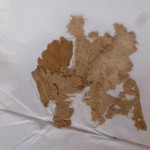In May 2012 John and I visited the excellent Textile Research Centre (TRC) in Leiden, Holland to take the Intensive Textile Course with six other people run by Dr. Gillian Vogelsang-Eastwood. The course provides a highly practical introduction to textiles – you learn the basics of spinning, weaving, dyeing and other processes. Gillian encourages you to find answers through experimentation.
The first day was an introduction to different fibre types and we each built up a reference collection of fibres. We developed our fibre identification skills and got to see different individual fibres under the microscope for the first time. This proved a conclusive way of telling cotton and linen apart (worn linen develops a fuzzy texture and it can be difficult to tell it apart from cotton).
We learnt about dyeing next and used natural dyes to dye wool. This was particularly interesting because we used different mordants – each mordant produced a different colour from the same dye! We can also confirm that indigo does smell of manure, although our dyeing attempts were unsuccessful. We also managed to dye madder more effectively than cochineal (see the 4th and 5th rows from the left).
Spinning was the next challenge, we tried out spindle whorls and spinning wheels. Neither John nor I are natural spinners and a morning was not enough to teach us the techniques and the rhythm needed to use a spindle whorl. However trying out the tools developed our understanding of spinning and reinforced the idea that for experienced spinners the process is intuitive and automatic as well as highlighting the importance of rhythm.

Recreating an archaeological textile
I much preferred weaving. After trying out weaving a tabby and different twills I helped Hedwig Landenius Enegren out with some experimental archaeology. We worked on recreating a design from the bottom of a garment based on a fragment of an archaeological textile. In the meantime John created a colour-coded treadle system on one of the basic looms.

Linen from the dead sea scrolls. Copyright Alice Dolan and Textile Reseach Centre, Leiden
The next few days were spent learning about decorative techniques and handling textiles from the CTR’s outstanding collection. One of the highlights of the trip for me was seeing some of the linen that was wrapped around the Dead Sea Scrolls.
So what did we learn?
- We developed our textile knowledge and gained a new understanding of the different processes involved in textile production before industrialisation.
- Our practical understanding of textiles improved. We learnt about the physicality of the processes, the rhythm needed for spinning and the smells of dyes.
- I had a go at experimental archaeology which can both provide (or suggest) answers and inspire new research questions. The outcome of this was that I tried growing flax to see how this changed my understanding of the fibre, the topic of another blog post.
We both heartily recommend the Intensive Textile Course as a solid foundation for academic textile research.







Pingback: Experimental archaeology – growing flax | The Spinning Project